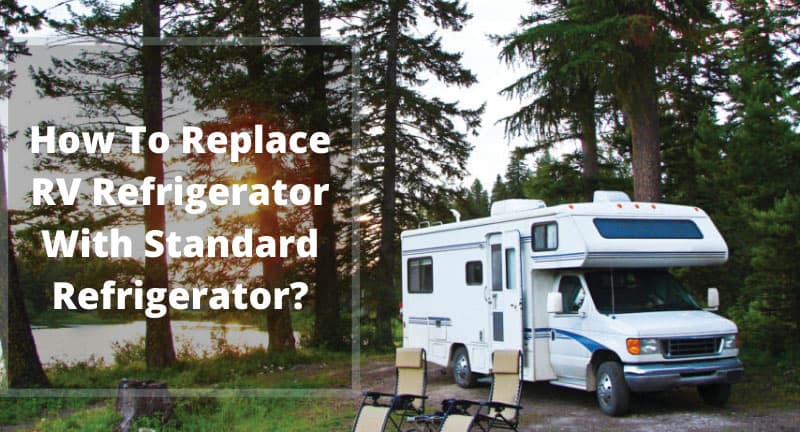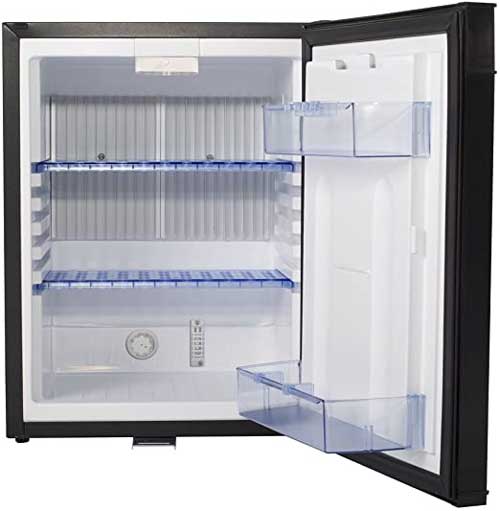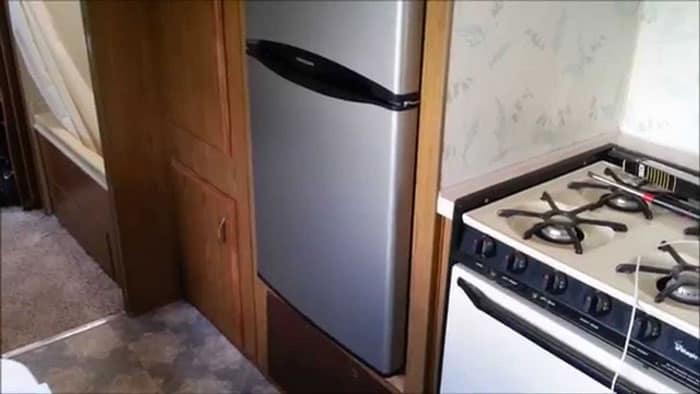How To Replace RV Refrigerator With Standard Refrigerator?
by William Sanders
If you're planning to replace your RV refrigerator with the standard home refrigerator, you have come to the right place.
Standard units offer you more space and better cooling precision that RV models, which explains why more Rvers than ever before are opting for the former.
The following guide will walk you everything you need to know about replacing your RV fridge with a regular model, including how to do the right way.
Contents

Is it wise to replace RV fridge with a regular one?
It's absolutely a good idea to replace your RV refrigerator with a residential unit. As we have just noted above, the residential units tend to outshine the RV fridges in terms of interior storage capacity, cooling precision, to name but a few.

If you live in the RV with your family, upgrading to a residential refrigerator is a wise decision as it'll help hold more food for your entire family.
And in case you're wondering whether this is even possible in the first place, the answer is a resounding YES! Many RVers have already upgraded to a regular fridge successfully. It's something you can do on your own if you're the handy type. But if you doubt your skills, you can hire an expert for the job.
Unfortunately, a home electric fridge might not meet the off-grid needs of dry camping enthusiasts.
Some of the key benefits you'll enjoy from using a standard fridge in your RV include
- Increased size: RV refrigerator has a limited size compared to the home unit. This is because of the shallow depth required for the absorption system situated at the unit's rear, leading to limited interior space.
- Standard fridges aren't level-sensitive: an RV fridge ought to be operated when in a level position. Failure to do this can lead to crystallization in the cooling coil, possibly damaging your unit. Though the home unit also requires level positioning, it's not highly sensitive to leveling as the RV units.
- More affordable to replace/repair: The best RV refrigerator is going to cost you more than a residential refrigerator. That's a fact. Moreover, repairs for RV units will cost you more than what you're used to paying for your home unit.
- Enhanced temperature precision and cooling accuracy: despite the high price tags attached to RV refrigerators, you'll become surprised to discover that they don't offer the same level of temperature precision and cooling accuracy as the standard units.
- More modern fridge features: RV refrigerators might not come with the latest in the fridge technology, e.g. water dispensers, in-door ice, self-defrost, timers, smart features, etc., making them less convenient than standard refrigerators.
How to replace your RV fridge with a residential fridge?
Assuming you have made up your mind to upgrade to a standard refrigerator, this section will take you through the steps to follow and key considerations to make to help you successfully upgrade to the new standard unit.

Step 1: Measure the space available for installing the new fridge.
You'll first need to measure where your current RV fridge is standing. This will help ensure you get the right size of a regular fridge that easily fits in the available space.
If you'll go for a counter depth residential unit, like many other Rvers, you'll need to measure the depth. You'll also need to get the distance from the door of your new fridge to anything that might stand on its way whenever you open it.
As for the height and width, there will always be room for adjustment when it comes to fitting your new unit in place.
Step 2: Determine how to get the RV fridge out (and the new one in)
Another important consideration you need to make beforehand is how your existing RV fridge will come out and you'll get the new unit in.
This can be as simple as measuring the width of your RV door and matching it with your fridges' widths to see if they hassle-freely pass through it.
If you think you'll have problems taking the fridges in/out through the door, then you can remove the window assembly on the RV driver side to make a pathway for the old and new units.
Step 3: Installing the new unit
Now that you have the necessary measurements at hand and a new unit ready for installation, it's time to get the job done.
You can choose to do the installation on your own or hire RV a repair and refurbishment company to get it done.
First, remove the old unit to pave way for the new. Start by disconnecting the 12V, 110V, propane line (be careful how you handle this line) and the ice maker line, if any. Avoid removing the cooling unit on the back to prevent caustic ammonia gas from escaping.
Now bring in the new unit and install it into place.
The most important thing to note during installation is that you'll need a 120V AC 15amp breaker plus line from panel at the rear section of where you install your new unit.
Connect the new unit to the ice maker liner and the power cord. And be sure to create adequate space at the rear of the unit to promote airflow over the condenser tubing for efficient operation.
Don't forget to secure the refrigerator to stop it from moving as you drive your RV. You might also want to find a way to secure the fridge doors during transit.
Finally, use floor strips and molding trim to get the unit planted solidly into place to give your new fridge a nice finishing.
Step 4: Power on the new unit
You're done installing your new fridge. You can now power it up and put your food into it.
When camping, your fridge will be running on the shore power.
And when dry camping or moving, it'll be powered by the inverter, which is powered by your house bank batteries. Keep in mind that most standard units require a pure sine wave inverter to work properly.
Final Verdict
Replacing an RV refrigerator with a residential model is a sure way to bring your home experience on board. You'll enjoy increased storage capacity, better cooling accuracy, and the convenient modern refrigerator features.
Follow our guide above to successfully replace your existing RV fridge with a standard fridge and enjoy the many benefits it comes with.
Remember that your new unit can use shore power as well as the inverter as its source of power.
 |
 |
 |
 |
 |
 |
 |
 |

About William Sanders
William Sanders was born and raised in California. After receiving his Master’s degree in information science from San Diego State University, he started working as a city councilor. In his spare time, William enjoys playing best-selling MMORPG games such as World of Warcraft and Fnal Fantasy, where he often takes on the role of guild leader with hundreds of players collaborating for success under his leadership. William is also a regular contributor to some popular magazines such as San Jose Mercury News, Gleanster Research, and Palmgear.
Leave a Reply
You can get FREE Gifts. Or latest Free phones here.
Disable Ad block to reveal all the info. Once done, hit a button below
 |
 |
 |
 |